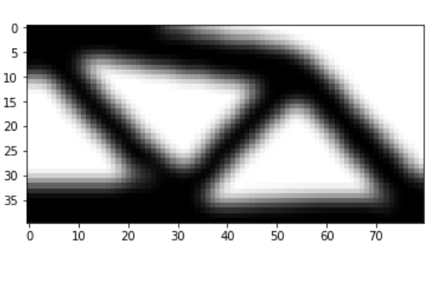In [ ]:
import numpy as np
import scipy.linalg as sla
import scipy.sparse as sparse
import matplotlib.pyplot as plt
%matplotlib inline
Topology design optimization¶

When performing optimization of structural problem, for example to obtain the bridge design above, you may want to use a numerical method called Finite Element Method. The optimization will consist of a series of solve of the form:
$$ {\bf K} {\bf u} = {\bf F} $$
Here will load the matrix $ {\bf K}$ from a file. The matrix is given in Compressed Sparse Column (CSC) format.
In [ ]:
K = sparse.load_npz('yourmatrix.npz')
K
In [ ]:
K.shape[0]**2/105912
We can spy the distribution of the non-zero entries of the matrix:
In [ ]:
plt.spy(K)
plt.show()
The matrix ${\bf K}$ has a banded format, and it is also symmetric and positive definite.
In [ ]:
Kdense = K.todense()
In [ ]:
np.max(Kdense-Kdense.T)
In [ ]:
sla.norm(Kdense-Kdense.T)
Solving the linear system of equations using different methods:
In [ ]:
F = np.zeros(K.shape[0])
F[1]=-1
LU factorization¶
In [ ]:
u1 = sla.solve(Kdense,F)
u1.shape
In [ ]:
%timeit sla.solve(Kdense,F)
In [ ]:
lu,p = sla.lu_factor(Kdense)
u2 = sla.lu_solve((lu,p),F)
u2.shape
In [ ]:
%timeit sla.lu_factor(Kdense)
%timeit sla.lu_solve((lu,p),F)
Cholesky factorization¶
In [ ]:
Kcho = sla.cholesky(Kdense)
u3 = sla.cho_solve((Kcho,False),F)
u3.shape
In [ ]:
%timeit sla.cholesky(Kdense)
%timeit sla.cho_solve((Kcho,False),F)
Sparse solve¶
In [ ]:
from scipy.sparse.linalg import spsolve
In [ ]:
u4 = spsolve(K,F)
u4.shape
In [ ]:
%timeit spsolve(K,F)